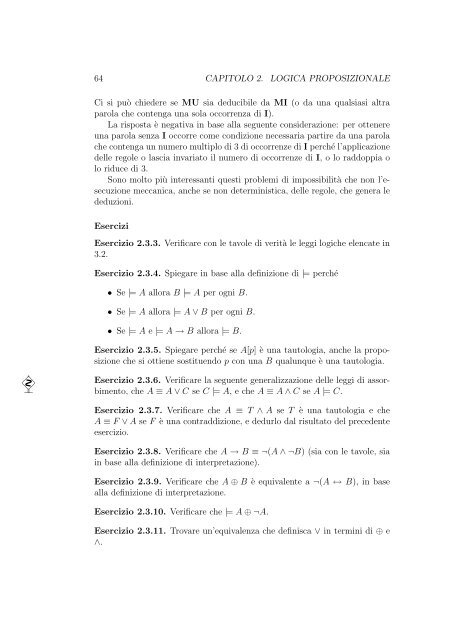Logica Matematica Corso di Laurea in Informatica ... - Mbox.dmi.unict.it
Logica Matematica Corso di Laurea in Informatica ... - Mbox.dmi.unict.it
Logica Matematica Corso di Laurea in Informatica ... - Mbox.dmi.unict.it
Create successful ePaper yourself
Turn your PDF publications into a flip-book with our unique Google optimized e-Paper software.
64 CAPITOLO 2. LOGICA PROPOSIZIONALE<br />
Ci si può chiedere se MU sia deducibile da MI (o da una qualsiasi altra<br />
parola che contenga una sola occorrenza <strong>di</strong> I).<br />
La risposta è negativa <strong>in</strong> base alla seguente considerazione: per ottenere<br />
una parola senza I occorre come con<strong>di</strong>zione necessaria partire da una parola<br />
che contenga un numero multiplo <strong>di</strong> 3 <strong>di</strong> occorrenze <strong>di</strong> I perché l’applicazione<br />
delle regole o lascia <strong>in</strong>variato il numero <strong>di</strong> occorrenze <strong>di</strong> I, o lo raddoppia o<br />
lo riduce <strong>di</strong> 3.<br />
Sono molto più <strong>in</strong>teressanti questi problemi <strong>di</strong> impossibil<strong>it</strong>à che non l’esecuzione<br />
meccanica, anche se non determ<strong>in</strong>istica, delle regole, che genera le<br />
deduzioni.<br />
Esercizi<br />
Esercizio 2.3.3. Verificare con le tavole <strong>di</strong> ver<strong>it</strong>à le leggi logiche elencate <strong>in</strong><br />
3.2.<br />
Esercizio 2.3.4. Spiegare <strong>in</strong> base alla def<strong>in</strong>izione <strong>di</strong> |= perché<br />
• Se |= A allora B |= A per ogni B.<br />
• Se |= A allora |= A ∨ B per ogni B.<br />
• Se |= A e |= A → B allora |= B.<br />
Esercizio 2.3.5. Spiegare perché se A[p] è una tautologia, anche la proposizione<br />
che si ottiene sost<strong>it</strong>uendo p con una B qualunque è una tautologia.<br />
Esercizio 2.3.6. Verificare la seguente generalizzazione delle leggi <strong>di</strong> assorbimento,<br />
che A ≡ A ∨ C se C |= A, e che A ≡ A ∧ C se A |= C.<br />
Esercizio 2.3.7. Verificare che A ≡ T ∧ A se T è una tautologia e che<br />
A ≡ F ∨ A se F è una contrad<strong>di</strong>zione, e dedurlo dal risultato del precedente<br />
esercizio.<br />
Esercizio 2.3.8. Verificare che A → B ≡ ¬(A ∧ ¬B) (sia con le tavole, sia<br />
<strong>in</strong> base alla def<strong>in</strong>izione <strong>di</strong> <strong>in</strong>terpretazione).<br />
Esercizio 2.3.9. Verificare che A ⊕ B è equivalente a ¬(A ↔ B), <strong>in</strong> base<br />
alla def<strong>in</strong>izione <strong>di</strong> <strong>in</strong>terpretazione.<br />
Esercizio 2.3.10. Verificare che |= A ⊕ ¬A.<br />
Esercizio 2.3.11. Trovare un’equivalenza che def<strong>in</strong>isca ∨ <strong>in</strong> term<strong>in</strong>i <strong>di</strong> ⊕ e<br />
∧.




![Introduzione ai sistemi Wiki [PDF] - Mbox.dmi.unict.it](https://img.yumpu.com/16413205/1/184x260/introduzione-ai-sistemi-wiki-pdf-mboxdmiunictit.jpg?quality=85)











